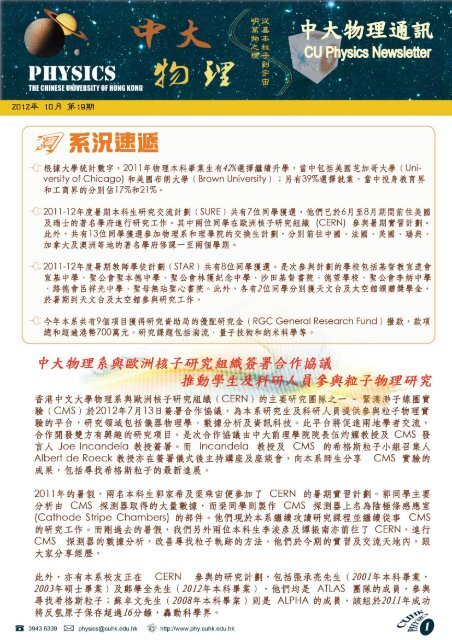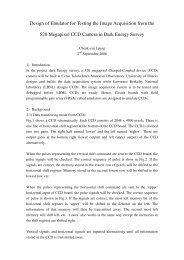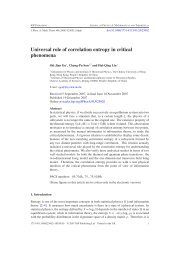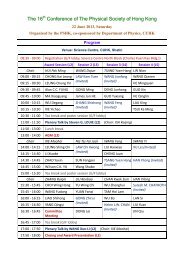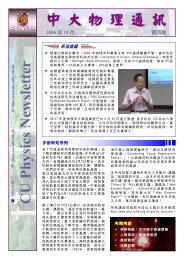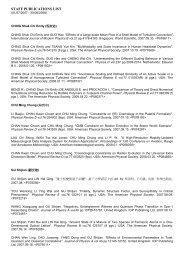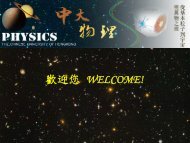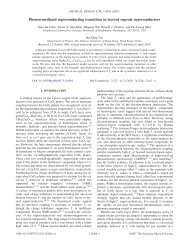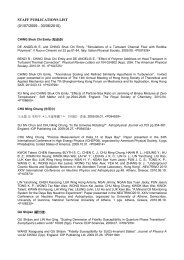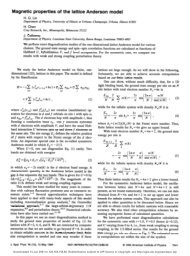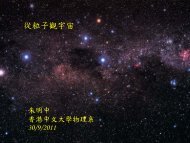19th Issue (Oct-2012) - Department of Physics - The Chinese ...
19th Issue (Oct-2012) - Department of Physics - The Chinese ...
19th Issue (Oct-2012) - Department of Physics - The Chinese ...
Create successful ePaper yourself
Turn your PDF publications into a flip-book with our unique Google optimized e-Paper software.
International Journal <strong>of</strong> Modern <strong>Physics</strong> A<br />
Vol. 27, No. 9 (<strong>2012</strong>) 1230009 (19 pages)<br />
c○ World Scientific Publishing Company<br />
DOI: 10.1142/S0217751X12300098<br />
MY EXPERIENCE AS STUDENT AND RESEARCHER<br />
Int. J. Mod. Phys. A <strong>2012</strong>.27. Downloaded from www.worldscientific.com<br />
by THE CHINESE UNIVERSITY OF HONG KONG on 10/09/12. For personal use only.<br />
C. N. YANG<br />
Tsinghua University, Beijing, China<br />
<strong>Chinese</strong> University <strong>of</strong> Hong Kong, Hong Kong<br />
Received 14 March <strong>2012</strong><br />
Accepted 15 March <strong>2012</strong><br />
Published 3 April <strong>2012</strong><br />
I was a student in Chongde () Middle School for four years 1933–1937, from<br />
Grade 7 to Grade 10. <strong>The</strong> school had about 300 students. It had a small library in<br />
which I developed the habit <strong>of</strong> browsing around. It was in that library that I had<br />
a first glimpse <strong>of</strong> modern physics through reading a <strong>Chinese</strong> translation <strong>of</strong> James<br />
Jeans’ <strong>The</strong> Mysterious Universe (Fig. 1).<br />
Fig. 1.<br />
Cover <strong>of</strong> the book <strong>The</strong> Mysterious Universe (Cambridge University Press).<br />
1230009-1
C. N. Yang<br />
Int. J. Mod. Phys. A <strong>2012</strong>.27. Downloaded from www.worldscientific.com<br />
by THE CHINESE UNIVERSITY OF HONG KONG on 10/09/12. For personal use only.<br />
In the book Jeans used daily language to describe the development <strong>of</strong> special<br />
relativity in 1905, <strong>of</strong> general relativity in 1915 and quantum mechanics in 1925. I<br />
was fascinated.<br />
In 1937 the war against Japanese invasion broke out. My family had to move<br />
through a long and difficult journey, arriving finally in the Spring <strong>of</strong> 1938 at Kunming<br />
(). I still vividly remember how the train in which we were riding between<br />
Wuhan () and Guangzhou () was bombed midway in Hunan Province<br />
(). In Kunming I skipped Grade 12 and took the entrance examination to the<br />
Southwest Associated University (Lianda ).<br />
I had not studied high school physics, so to prepare for the entrance examination<br />
I borrowed a copy <strong>of</strong> a standard high school physics textbook and read it through in<br />
several weeks. At the end <strong>of</strong> this reading I concluded that physics was the subject<br />
that I liked. Thus when I registered at Lianda I enrolled in the <strong>Department</strong> <strong>of</strong><br />
<strong>Physics</strong>.<br />
I still remember, that textbook stated that the acceleration in a uniform circular<br />
motion is centripetal and not along the tangential direction. I felt at first that this<br />
contradicted my intuition. But after thinking about it for a couple <strong>of</strong> days I finally<br />
realized that velocity is a vector. It has not only magnitude but also direction. This<br />
story taught me an important lesson: We all have intuitions. Most <strong>of</strong> them are<br />
correct. But some need revision. Thus<br />
On the one hand our intuitions are extremely important.<br />
But on the other hand one must constantly absorb new (1)<br />
concepts to revise one’s intuitions.<br />
In the Spring <strong>of</strong> 1942, to write a B.Sc. thesis required by the University, I went<br />
to see Pr<strong>of</strong>essor T. Y. Wu () (Fig. 2), asking him to be my advisor. Forty<br />
years later I thus described how Pr<strong>of</strong>essor Wu gave me guidance. 1<br />
Fig. 2. Pr<strong>of</strong>essor T. Y. Wu (1907–2000) and I (taken in Stony Brook in 1982).<br />
1230009-2
My Experience as Student and Researcher<br />
He gave me a copy <strong>of</strong> an article by J. E. Rosenthal and G. M. Murphy in<br />
the 1936 volume <strong>of</strong> Reviews <strong>of</strong> Modern <strong>Physics</strong>. It was a review paper on<br />
group theory and molecular spectra. I was thus introduced to group theory<br />
in physics. In retrospect I am deeply grateful to Wu for this introduction,<br />
since it had a pr<strong>of</strong>ound effect on my subsequent development as a physicist.<br />
Int. J. Mod. Phys. A <strong>2012</strong>.27. Downloaded from www.worldscientific.com<br />
by THE CHINESE UNIVERSITY OF HONG KONG on 10/09/12. For personal use only.<br />
Group theory’s applications in physics later became my principal area <strong>of</strong> work,<br />
comprising approximately two thirds <strong>of</strong> my research efforts.<br />
In the fall <strong>of</strong> 1942 I enrolled as a graduate student in the <strong>Physics</strong> <strong>Department</strong><br />
<strong>of</strong> Lianda. My M.Sc. thesis advisor was Pr<strong>of</strong>essor J. S. Wang () (Fig. 3). His<br />
specialty was statistical mechanics and he guided me into this area <strong>of</strong> research.<br />
Approximately one third <strong>of</strong> my later research work was in this area.<br />
Fig. 3. Pr<strong>of</strong>essor J. S. Wang (1911–1983) (taken by H. T. Nieh in 1980).<br />
Many years later I made the following description <strong>of</strong> my graduate days in<br />
Lianda: 2<br />
During the academic year 1941–42 I was a senior in the <strong>Physics</strong> <strong>Department</strong><br />
at the National Southwest Associated University in Kunming. <strong>The</strong><br />
<strong>Department</strong> was quite small, with about ten faculty members, ten instructors,<br />
a few graduate students and not more than 20 students in each undergraduate<br />
class. When the academic year started in the fall <strong>of</strong> 1941, a new<br />
face appeared, auditing many <strong>of</strong> the senior and graduate courses and participating<br />
in all discussions. That was Huang Kun. He had already received<br />
his bachelor’s degree in physics from Yenching University in Beiping, and<br />
had come to Kunming to join the Southwest Associated University as an<br />
instructor. Soon we got to know each other well, and that was the beginning<br />
<strong>of</strong> half <strong>of</strong> a century <strong>of</strong> warm friendship.<br />
1230009-3
C. N. Yang<br />
Int. J. Mod. Phys. A <strong>2012</strong>.27. Downloaded from www.worldscientific.com<br />
by THE CHINESE UNIVERSITY OF HONG KONG on 10/09/12. For personal use only.<br />
Fig. 4. Huang Kun (), Sheldon Chang (), and I (taken at the birthday party for celebrating<br />
Zhou Pei-Yuan’s birthday at Peking University on June 1st, 1992).<br />
Two <strong>of</strong> the courses we took that year were Pr<strong>of</strong>essor Ta-You Wu’s<br />
() classical mechanics and quantum mechanics. Quantum mechanics<br />
was a revolutionary development in physics which had started in Germany,<br />
Switzerland, England and Denmark in the years 1925 to 1927. Pr<strong>of</strong>essor<br />
Wu was the physicist in China who trained during the 1930’s and early<br />
1940’s the greatest number <strong>of</strong> students in this important new fundamental<br />
branch <strong>of</strong> physics. I remember many discussions after Pr<strong>of</strong>essor Wu’s lectures.<br />
It was through these discussions that I first got to know Huang Kun<br />
well, as a physicist and as a person.<br />
A year later, in the summer <strong>of</strong> 1942, Huang Kun and I both enrolled as<br />
graduate students at the Southwest Associated University. He worked on<br />
his thesis with Pr<strong>of</strong>essor Wu on atomic and molecular problems in astrophysics,<br />
while I worked on mine with Pr<strong>of</strong>essor Wang Zhu-Xi (J. S. Wang)<br />
() on statistics mechanics. <strong>The</strong> graduate students’ stipend was meager<br />
and we all looked for teaching positions to supplement our incomes.<br />
My father was a friend <strong>of</strong> President Xu Ji-Zu () <strong>of</strong> Kun Hua Middle<br />
School () who arranged to have Huang Kun, me and Zhang Shou-<br />
Lien ( Sheldon Chang), a fellow physics graduate student, split a<br />
teaching position at the School. As part <strong>of</strong> the package deal, the School<br />
gave us a corner room in one <strong>of</strong> their new buildings for the three <strong>of</strong> us to<br />
live in.<br />
<strong>The</strong> School was situated approximately 3 km from the campus <strong>of</strong> the<br />
Southwest Associated University. Huang, Chang and I would spend our day<br />
on the University campus, taking our meals in the mess hall on campus,<br />
returning to our room at the School in the evening to sleep. <strong>The</strong>re was<br />
no facility for producing potable water on the University campus, so we<br />
1230009-4
My Experience as Student and Researcher<br />
Int. J. Mod. Phys. A <strong>2012</strong>.27. Downloaded from www.worldscientific.com<br />
by THE CHINESE UNIVERSITY OF HONG KONG on 10/09/12. For personal use only.<br />
developed the habit <strong>of</strong> spending an hour or two everyday after supper,<br />
drinking tea in one <strong>of</strong> the tea houses clustered along the three streets near<br />
the campus before returning to the School. During these hours and hours <strong>of</strong><br />
tea drinking, we really got to know each other well. We discussed and argued<br />
about everything under the sun: from ancient history to contemporary<br />
politics, from large cultural patterns in the world to small details in some<br />
movies we had recently seen. In all <strong>of</strong> these, I remember Huang Kun as a<br />
fair debator, not given to tricking his opponents. I also remember that he<br />
had a tendency to push his arguments to the extreme. Many years later<br />
when I reflected on this, I found it interesting how this tendency <strong>of</strong> his had<br />
seemed to be totally absent in his physics.<br />
Our fellow tea drinkers formed a colorful and curious group. <strong>The</strong>re were<br />
many students like us. But the majority <strong>of</strong> the tea drinkers were towns<br />
folks, horse carriage drivers, traders from distant counties and the like.<br />
Everyone was noisy. We especially. Oftentimes during a heated debate we<br />
would suddenly become aware that we were by far the noisiest and that<br />
everyone was watching us. (That awareness may or may not terminate our<br />
argument.) However, there was rarely any animosity between us and the<br />
nonstudents in the tea houses.<br />
We experienced, during these hours <strong>of</strong> tea drinking, scenes and events<br />
that I was never to forget. Several times, sitting in the tea houses along<br />
Fung Du Street () which led northward away from the city into<br />
small hills dotted with simple tombs, we saw processions <strong>of</strong> soldiers marching<br />
in the northward direction with one or several prisoners in their midst.<br />
Each prisoner had a white picket-like cardboard tied to his back with his<br />
name and crime written on it. Most <strong>of</strong> the prisoners marched in silence. A<br />
few would yell something which sounded like: “Twenty years later, again<br />
a brave fellow!” Every time such a procession passed, the noise level in<br />
the tea house would drop perceptibly. <strong>The</strong>n the expected distant gun<br />
shots, and we would sit silently, waiting to watch the soldiers marching<br />
back.<br />
Against such background happenings, we argued endlessly about<br />
physics. I remember once our topic <strong>of</strong> discussion was about the meaning<br />
<strong>of</strong> measurements according to the Copenhagen interpretation <strong>of</strong> quantum<br />
mechanics. That is a very subtle subject, and our arguments started at tea,<br />
lasted throughout the evening, and continued back in our room at the Kun<br />
Hua Middle School. After the electric lights were turned <strong>of</strong>f and we were<br />
all in bed, the arguments did not stop.<br />
It is no longer clear to me today what precise point we were arguing<br />
about that evening, nor who among us took which side. But I vividly<br />
remember that all three <strong>of</strong> us eventually got up from our beds, lit candles<br />
and examined in detail a few paragraphs <strong>of</strong> Heisenberg’s <strong>The</strong> Physical<br />
Principle <strong>of</strong> the Quantum <strong>The</strong>ory to settle our argument.<br />
1230009-5
C. N. Yang<br />
Int. J. Mod. Phys. A <strong>2012</strong>.27. Downloaded from www.worldscientific.com<br />
by THE CHINESE UNIVERSITY OF HONG KONG on 10/09/12. For personal use only.<br />
Huang was an avid reader <strong>of</strong> English novels. It was he who introduced<br />
me to Joseph Conrad, Rudyard Kipling, John Galsworthy and other<br />
authors. Many <strong>of</strong> the novels <strong>of</strong> these authors we borrowed from the University<br />
libraries. Others we bought from the stalls that sold K-rations, army<br />
boots, cans <strong>of</strong> cheese as well as used pocket books with which the U.S.<br />
military personnel flooded the flea markets <strong>of</strong> Kunming.<br />
It was a simple life we led in those years, as I have described elsewhere.<br />
A dish <strong>of</strong> peanuts to go with the tea was a great treat, which we could not<br />
indulge in very <strong>of</strong>ten. It was not an austere life, for we did not expect and<br />
did not desire more material things. It was also not a frustrated life, for<br />
we found plenty <strong>of</strong> intellectual stimulation and satisfaction. It was just a<br />
very simple life which, without our realizing it at the time, had shaped our<br />
tastes and styles in physics in ways that were to have pr<strong>of</strong>ound effects on<br />
our later careers.<br />
My discussions/arguments with Huang Kun and Sheldon Chang and my later<br />
experience as a pr<strong>of</strong>essor <strong>of</strong> physics taught me:<br />
Discussions with classmates <strong>of</strong>fer opportunities for deep<br />
understanding.<br />
Sheldon Chang later moved to Electrical Engineering and Control <strong>The</strong>ory,<br />
obtaining his Ph.D. in the U.S. He is now a Pr<strong>of</strong>essor Emeritus <strong>of</strong> Stony Brook University.<br />
Huang Kun (1919–2005) later received his Ph.D. degree in Great Britain,<br />
specializing in solid state physics in which he made very important contributions.<br />
He was also the father <strong>of</strong> semiconductor research in China. In 2001 he received the<br />
highest Science Award <strong>of</strong> China.<br />
A few weeks after the end <strong>of</strong> World War II in 1945 I flew on a DC3 to Calcutta,<br />
where I had to wait for a berth on ships bound for the U.S. for several months,<br />
finally arriving in New York on November 24th after a long voyage through the Red<br />
Sea, Suez Canal and the Mediterranean. In January 1946 I enrolled as a graduate<br />
student in the <strong>Physics</strong> <strong>Department</strong> <strong>of</strong> the University <strong>of</strong> Chicago. My aim was to<br />
write an experimental Ph.D. thesis with Pr<strong>of</strong>essor Enrico Fermi (1901–1954, Fig. 5).<br />
In 2001 there were celebrations in Chicago and in Rome for Fermi’s 100th birthday.<br />
In the paper I read at these celebrations was the following passage: 3<br />
(2)<br />
Enrico Fermi was, <strong>of</strong> all the great physicists <strong>of</strong> the 20th century, among<br />
the most respected and admired. He was respected and admired because <strong>of</strong><br />
his contributions to both theoretical and experimental physics, because <strong>of</strong><br />
his leadership in discovering for mankind a powerful new source <strong>of</strong> energy,<br />
and above all, because <strong>of</strong> his personal character. He was always reliable<br />
and trustworthy. He had both <strong>of</strong> his feet on the ground all the time. He<br />
had great strength, but never threw his weight around. He did not play to<br />
the gallery. He did not practise one-up-manship. He exemplified, I always<br />
believe, the perfect Confucian gentleman.<br />
1230009-6
My Experience as Student and Researcher<br />
Int. J. Mod. Phys. A <strong>2012</strong>.27. Downloaded from www.worldscientific.com<br />
by THE CHINESE UNIVERSITY OF HONG KONG on 10/09/12. For personal use only.<br />
Fig. 5. Enrico Fermi (taken in 1940’s). Fig. 6. Edward Teller and I (taken in 1982).<br />
At the time the <strong>Physics</strong> <strong>Department</strong> <strong>of</strong> the University <strong>of</strong> Chicago was ranked<br />
No. 1 or 2 in the world. Besides Fermi, another important theoretical pr<strong>of</strong>essor<br />
was Edward Teller (1908–2003, Fig. 6). He was a brilliant scientist who had made<br />
important contributions in physics and in chemistry. Later in the early 1950’s<br />
he discovered the method <strong>of</strong> constructing a hydrogen bomb and became world<br />
famous.<br />
My plan to write an experimental thesis with Fermi did not materialize because<br />
his laboratory at the time was in the Argonne National Laboratory which was not<br />
open to me. So Fermi recommended that I first work with Teller on theory.<br />
During the first half <strong>of</strong> 1946 I was Teller’s graduate student. <strong>The</strong> first research<br />
problem he gave me was about the lifetimes <strong>of</strong> K-capture in Be and in BeO. He<br />
proposed that I use the Thomas–Fermi–Dirac and the Wigner–Seitz approximations<br />
to do the calculation. Several weeks later I showed him my results and he happily<br />
arranged for me to give a seminar. That was my first seminar report in America.<br />
In the small audience <strong>of</strong> less than twenty people there were several very important<br />
scientists: Fermi, Urey, the Mayers, etc. My report received universal approval, and<br />
Teller asked me to write it up for publication. I then spent approximately a whole<br />
week to do this but without success, since I could not adequately estimate the<br />
reliability <strong>of</strong> my results which involved several different kinds <strong>of</strong> approximations.<br />
Fortunately Teller was not <strong>of</strong>fended and he gave me another problem on nuclear<br />
physics.<br />
1230009-7
C. N. Yang<br />
Int. J. Mod. Phys. A <strong>2012</strong>.27. Downloaded from www.worldscientific.com<br />
by THE CHINESE UNIVERSITY OF HONG KONG on 10/09/12. For personal use only.<br />
Teller had six or seven graduate students at that time. We met to discuss physics<br />
once or twice a week, <strong>of</strong>tentimes also to have lunch with him. Teller had lots <strong>of</strong> new<br />
ideas concerning nuclear physics, solid state physics, cosmic rays, etc. Gradually I<br />
found his style <strong>of</strong> research was different from my own. Thus while I continued to<br />
participate in his discussion group, I began to look for theoretical problems myself.<br />
In the fall <strong>of</strong> 1946 Fermi recommended me to work in the laboratory <strong>of</strong> Pr<strong>of</strong>essor<br />
Allison. Allison was an experimental nuclear physicist. At the time he was<br />
constructing a 400 keV Cockr<strong>of</strong>t–Walton accelerator. He had five or six graduate<br />
students and accepted me as an additional one. In the meantime I continued to<br />
participate in Teller’s discussion group.<br />
At the time I was one <strong>of</strong> the most prominent graduate students in the <strong>Physics</strong><br />
<strong>Department</strong> because what I had learned in Lianda <strong>of</strong> fundamental theoretical<br />
physics had already reached the frontiers <strong>of</strong> the field at the time. But I was very<br />
clumsy in the laboratory. Laboratory mates respected my theoretical knowledge,<br />
<strong>of</strong>tentimes asking me to help them to solve theoretical problems. But they laughed<br />
at my blunders in the laboratory. “Where there is a Bang, there is Yang!”<br />
1947 was a year <strong>of</strong> unhappiness for me. In a letter I wrote to Huang Kun who<br />
was then a graduate student in England, I had used the word “disillusioned” to<br />
describe my feelings at the time. Why? Because although I was trying hard but I<br />
did not have the talents to do experiments. On the other hand in theoretical physics<br />
all the topics that I had concentrated on myself were leading to pure frustration.<br />
It is very common for a graduate student to feel discouraged<br />
in looking for a good problem for his/her thesis work.<br />
<strong>The</strong> theoretical problems that I worked on myself in the year 1947 included the<br />
following items:<br />
(1) Onsager’s 1944 paper on Ising Model.<br />
(2) Bethe’s 1931 paper on Spin Waves.<br />
(3) Pauli’s 1941 review paper on Field <strong>The</strong>ory.<br />
(4) Many papers after 1943 on angular distributions in nuclear reactions.<br />
Of these four topics the first two were in statistical mechanics. I was interested<br />
in them because <strong>of</strong> the influence <strong>of</strong> Pr<strong>of</strong>essor J. S. Wang. <strong>The</strong> other two problems<br />
were related to the concept <strong>of</strong> symmetry. I was interested in them because <strong>of</strong> the<br />
influence <strong>of</strong> Pr<strong>of</strong>essor T. Y. Wu.<br />
In the <strong>Physics</strong> <strong>Department</strong> in the University <strong>of</strong> Chicago at that time nobody<br />
was interested in the first three <strong>of</strong> these problems. I worked on them by myself in<br />
the department library, trying to understand the papers on these problems, and<br />
hoping to make further advances. <strong>The</strong> end result <strong>of</strong> several weeks <strong>of</strong> hard work on<br />
each <strong>of</strong> these three topics was total frustration.<br />
Fortunately Teller was very much interested in the fourth problem. At that time<br />
there were many theoretical papers on this topic. I found all <strong>of</strong> them were intuitive<br />
and lacked rigour. So I spent several weeks applying the concept <strong>of</strong> “Invariance <strong>of</strong><br />
(3)<br />
1230009-8
My Experience as Student and Researcher<br />
Int. J. Mod. Phys. A <strong>2012</strong>.27. Downloaded from www.worldscientific.com<br />
by THE CHINESE UNIVERSITY OF HONG KONG on 10/09/12. For personal use only.<br />
Physical Laws under Space Rotation” to substantiate the intuitive ideas floating in<br />
the literature on the subject. <strong>The</strong> effort was successful and I wrote a short paper<br />
which Teller very much liked. At that time everybody in the department knew that<br />
Frank Yang’s work in Allison’s laboratory was unsuccessful. One day in the spring <strong>of</strong><br />
1948 Teller came to Allison’s laboratory 4 and suggested that I abandon my plan to<br />
write an experimental thesis. He would sponsor my short paper as my Ph.D. thesis<br />
after I had extended it to include relativistic cases. I was at first disheartened by<br />
Teller’s proposal, but after a few days recovered and accepted his suggestion with<br />
relief.<br />
Altogether I spent about 18 to 20 months in Allison’s laboratory. Was that a<br />
complete waste <strong>of</strong> time? No, absolutely not! Through that experience I learned that<br />
the value judgement <strong>of</strong> an experimental physicist was very different from that <strong>of</strong><br />
a theoretical physicist. This understantding influnenced many <strong>of</strong> my later research<br />
work, including the 1956 work on the possibility <strong>of</strong> parity nonconservation and my<br />
1964 paper with T. T. Wu on phenomenological analysis <strong>of</strong> CP invariance. 5<br />
My Ph.D. thesis was the first paper I published concerning invariance and noninvariance<br />
<strong>of</strong> physical laws. Soon after I published a second paper in this field, about<br />
the spin <strong>of</strong> π 0 meson through a careful analysis <strong>of</strong> the group theoretical representation<br />
<strong>of</strong> invariance in field theory. <strong>The</strong>se two papers established me as one <strong>of</strong> the<br />
foremost theorist on the use <strong>of</strong> group theory in analysing symmetry properties. It<br />
was then that this field was beginning and I was very fortunate to have gotten into<br />
it at its infancy.<br />
It is best to enter a research area when it is new and developing. (4)<br />
After I got my Ph.D. degree in the summer <strong>of</strong> 1948, the University <strong>of</strong> Chicago<br />
appointed me as an instructor. At that time the hottest theoretical area <strong>of</strong> research<br />
was renormalization theory. <strong>The</strong> three theory pr<strong>of</strong>essors in Chicago: Fermi, Teller<br />
and Wentzel were not working in this field. <strong>The</strong>refore after one year 1948–1949<br />
I moved to the Institute for Advanced Study (IAS) in Princeton. Before leaving<br />
Chicago Fermi told me it was good to spend some time at the IAS, but the work<br />
there was too academic. It was a bit like a medieval cloister, he said, and was not<br />
a place for long stay. So he suggested that I go to the IAS for one year and then<br />
return to Chicago. I was <strong>of</strong> course totally in agreement with this advice <strong>of</strong> his. But 6<br />
because <strong>of</strong> the convenience <strong>of</strong> dating Miss Tu (later my wife) in New York City,<br />
I did not return to Chicago after one year and instead remained at the IAS for<br />
altogether seventeen years, 1949–1966.<br />
During these seventeen years the four topics that I had worked on by myself<br />
in Chicago, described above, all became successful areas <strong>of</strong> research for me. <strong>The</strong><br />
breakthrough for the first item, Onsager’s work on the Ising Model, had come about<br />
accidentally: 7<br />
One day in early November, 1949, in a ride in the station wagon that<br />
the Institute ran from Palmer Square opposite Princeton Univeristy to the<br />
1230009-9
C. N. Yang<br />
Int. J. Mod. Phys. A <strong>2012</strong>.27. Downloaded from www.worldscientific.com<br />
by THE CHINESE UNIVERSITY OF HONG KONG on 10/09/12. For personal use only.<br />
Institute, J. M. Luttinger and I happened to talk about the Ising model.<br />
Luttinger said that Bruria Kaufman had simplified Onsager’s method<br />
so that the solution could be understood in terms <strong>of</strong> the representation<br />
<strong>of</strong> a system <strong>of</strong> 2n anticommuting Hermitian matrices. I knew such representations<br />
well and understood quite readily the main points <strong>of</strong> the<br />
Onsager–Kaufman method. After arriving at the Institute, I worked out<br />
the essential steps <strong>of</strong> this approach and was very happy at finally understanding<br />
Onsager’s solution ...<br />
I kept thinking about it, and realized that Onsager and Kaufman had<br />
obtained much more information than just the partition function ,...<br />
I was thus led to a long calculation, the longest in my career. Full <strong>of</strong><br />
local, tactical tricks, the calculation proceeded by twists and turns. <strong>The</strong>re<br />
were many obstrctions. But always, after a few days, a new trick was somehow<br />
found that pointed to a new path. <strong>The</strong> trouble was that I soon felt<br />
I was in a maze and was not sure whether in fact, after so many turns, I<br />
was anywhere nearer the goal than when I began. This kind <strong>of</strong> strategic<br />
overview was very depressing, and several times I almost gave up. But each<br />
time something drew me back, usually a new tactical trick that brightened<br />
the scene, even though only locally.<br />
Finally, after about six months <strong>of</strong> work <strong>of</strong>f and on, all the pieces suddenly<br />
fitted together, producing miraculous cancellation, and I was staring<br />
at the amazingly simple final result.<br />
Why was I able to “understood quite readily the main points <strong>of</strong> the Onsager–<br />
Kaufman method”? One: I had thoroughly studied the representation <strong>of</strong> 2n anticommuting<br />
Hermitian matrices when I studied Dirac’s equation in Kunming. Two:<br />
I had spent several weeks in 1947 in Chicago trying to understand Onsager’s 1944<br />
paper, without success. But that experience had thoroughly familiarized me with<br />
Onsager’s paper. Combining these two earlier efforts I was able to rapidly understand<br />
what Luttinger had said about the real strategy <strong>of</strong> Onsager’s solution.<br />
What I had learned from Pr<strong>of</strong>essor J. S. Wang in Kunming made me deeply<br />
interested in statistical mechanics, leading to my preparatory efforts in Chicago<br />
on Onsager’s work. <strong>The</strong> final breakthrough came from a short conversation with<br />
Luttinger. This process:<br />
Interest → Preparation → Breakthrough, (5)<br />
I think, is the necessary three-step process for any research work. In the experience<br />
described above the breakthrough came from an external stimulation (conversation<br />
with Luttinger). But in most cases the breakthrough is a sudden inspiration without<br />
external stimulation: After long preparation, when one is not thinking about<br />
the problem, apparently new conceptual combinations were still being formed subconsciously<br />
in one’s brain. When the right combination occurs a sudden inspiration<br />
would result. A century earlier Poincaré 8 had given a very interesting analysis <strong>of</strong><br />
this process.<br />
1230009-10
My Experience as Student and Researcher<br />
<strong>The</strong> third problem I had unsuccessfully worked on in Chicago was about the concept<br />
<strong>of</strong> gauge invariance in electromagnetism in Pauli’s 1941 review paper. Gauge invariance<br />
was invented by Hermann Weyl (1885–1955, Fig. 7) in the years 1918–1929.<br />
I was deeply interested in this beautiful concept and wanted in 1947 to generalize<br />
it. (Why had my fellow graduate students at the time not launched into similar<br />
efforts? I think it is because I was especially interested in group theory and in<br />
the concept <strong>of</strong> invariance in physics, subjects in which most <strong>of</strong> my fellow graduate<br />
students at the time were not interested.)<br />
Int. J. Mod. Phys. A <strong>2012</strong>.27. Downloaded from www.worldscientific.com<br />
by THE CHINESE UNIVERSITY OF HONG KONG on 10/09/12. For personal use only.<br />
Fig. 7. Hermann Weyl (1885–1955).<br />
I started with an important formula in electromagnetism<br />
F µν = A µ,ν − A ν,µ<br />
and generalized it to<br />
F µν = B µ,ν − B ν,µ ,<br />
(A)<br />
(B)<br />
in which B µ is a 2×2 square matrix, unlike A µ , which is a simple 1×1matrix.This<br />
very natural generalization however led to increasingly complicated calculations.<br />
Thus I had to give up. That was in 1947. My aim was to use this generalized gauge<br />
invariance to construct the mutual interactions between the many particles, Λ, K,<br />
etc., which were newly discovered at the time. Figure 8 are reproductions from three<br />
pages <strong>of</strong> my notes <strong>of</strong> 1947.<br />
More and more new particles were discovered in the succeeding few years. So<br />
several times I returned to this attempt at generalizing gauge invariance to formulate<br />
interactions between them. But each time the formulae became increasingly<br />
complex, increasingly ugly, and I had to give up. Finally in 1953 to 1954 I was<br />
1230009-11
C. N. Yang<br />
Int. J. Mod. Phys. A <strong>2012</strong>.27. Downloaded from www.worldscientific.com<br />
by THE CHINESE UNIVERSITY OF HONG KONG on 10/09/12. For personal use only.<br />
Fig. 8. Reproductions from three pages <strong>of</strong> the notes <strong>of</strong> 1947.<br />
visiting the Brookhaven National Laboratory (BNL) for one year. I had two young<br />
<strong>of</strong>ficemates at BNL that year. One was Robert Mills (1927–1999, Fig. 9) who was a<br />
student <strong>of</strong> Norman Kroll (1922–2004) and was just about to get his Ph.D. degree.<br />
Another one was an experimental physics graduate student Burton Richter (1931–)<br />
who later shared the Nobel Prize in physics in 1976 with Samuel Ting.<br />
Fig. 9. Robert Mills and I (taken in Stony Brook on May 22nd, 1999).<br />
Naturally in my discussions with Mills I mentioned my unsuccessful attempts to<br />
generalize gauge invariance. One day somehow we said although formula (B) was<br />
quite natural but maybe it should be amended to become<br />
F µν = B µ,ν − B ν,µ +(B µ and B ν polynomial) ,<br />
(C)<br />
1230009-12
My Experience as Student and Researcher<br />
in order to possibly cancel out the “increasingly complex” terms. We decided to<br />
first try a quadratic polynomial. If that did not work we would try a cubic one,<br />
etc., etc. Fortunately we rapidly found that if we replaced (B) with<br />
Int. J. Mod. Phys. A <strong>2012</strong>.27. Downloaded from www.worldscientific.com<br />
by THE CHINESE UNIVERSITY OF HONG KONG on 10/09/12. For personal use only.<br />
F µν = B µ,ν − B ν,µ + B µ B ν − B ν B µ ,<br />
the subsequent calculation became increasingly simple. Thus we knew we had uncovered<br />
a great treasure!!! [We did not know then that from a geometrical viewpoint<br />
it was natural to include the quadratic terms in (D).]<br />
With this breakthrough we followed the theory <strong>of</strong> Maxwell (1831–1879) and<br />
quickly wrote down a set <strong>of</strong> equations for generalized gauge theory. It was truly<br />
beautiful. But it had a problem: It seemed to imply that there should be massless<br />
charged particles which had never been seen. Besides it was difficult to understand<br />
how a charged particle could be massless. This problem caused us several months <strong>of</strong><br />
complicated and fruitless research. <strong>The</strong>re was also a famous episode <strong>of</strong> unpleasant<br />
criticism from Pauli. 9 Finally we decided although we did not have a good solution<br />
to this problem, the whole idea was too beautiful not to be published. Our paper<br />
was sent to the Physical Review in June, 1954. Fortunately it was immediately<br />
accepted and was published in <strong>Oct</strong>ober.<br />
This paper is my most important contribution to physics. It led to the principle<br />
that symmetry dictates interactions which in a sense is one part <strong>of</strong> Einstein’s<br />
geometrization <strong>of</strong> physics.<br />
<strong>The</strong> paper did not answer the massless particle question mentioned above, but<br />
our decision to publish, in retrospect, was absolutely correct. I learned from this:<br />
It is <strong>of</strong>ten not possible to solve at once all aspects <strong>of</strong> a<br />
difficult problem.<br />
About the problem <strong>of</strong> massless particles, the idea <strong>of</strong> symmetry breaking was<br />
introduced around 1970. With this additional idea there later was developed a very<br />
successful “standard model.” Since at that time I did not like to introduce symmetry<br />
breaking into a fundamental theory, 10 I lost the opportunity to make contributions<br />
in this area <strong>of</strong> research.<br />
About the collaboration between Mills and me, Mr. Wang Zhi () <strong>of</strong> CCTV<br />
interviewd me on January 26th, 2005 in Beijing. He asked why my research work was<br />
<strong>of</strong>ten done in collaboration with other physicists. <strong>The</strong> following was my answer: 11<br />
(D)<br />
(6)<br />
<strong>The</strong>re are many advantages in scientific collaboration. When you are working<br />
on a problem, sometimes you get stuck, you get discouraged. If at that<br />
time another person discusses the problem with you, asking you questions,<br />
suggesting a new direction for consideration, etc., your interest might be<br />
rekindled.<br />
Thus I believe:<br />
Discussions with colleagues is <strong>of</strong>tentimes a very fruitful<br />
method <strong>of</strong> research.<br />
(7)<br />
1230009-13
C. N. Yang<br />
Int. J. Mod. Phys. A <strong>2012</strong>.27. Downloaded from www.worldscientific.com<br />
by THE CHINESE UNIVERSITY OF HONG KONG on 10/09/12. For personal use only.<br />
Between 1954 to 1956 many new particles were found. Particularly interesting<br />
were two particles θ and τ, which decay into two or three π mesons:<br />
θ → π + π,<br />
τ → π + π + π.<br />
Increasingly more accurate experiments showed that θ and τ have approximately<br />
the same masses and the same lifetimes, indicating they might in fact be the same<br />
particle which had two different modes <strong>of</strong> decay. <strong>The</strong>re is nothing strange about<br />
this EXCEPT IT WOULD VIOLATE THE LAW OF PARITY CONSERVATION:<br />
Accordingtothislawthe“parity”<strong>of</strong>twoπ’s is +1 and <strong>of</strong> three π’s is −1. If θ and<br />
τ are the same particle then it can decay into +1 parity and also into −1 parity.<br />
Parity is thus not conserved. That is absolutely impossible! This dilemma was called<br />
the θ–τ puzzle and was the most puzzling problem in fundamental physics in the<br />
years 1954 to 1956. In a 1957 paper I said: 12<br />
<strong>The</strong> situation that the physicist found himself in at that time has been<br />
likened to a man in a dark room groping for an outlet. He is aware <strong>of</strong> the<br />
fact that in some direction there must be a door which would lead him out<br />
<strong>of</strong> his predicament. But in which direction?<br />
In the summer <strong>of</strong> 1956 T. D. Lee and I (Fig. 10) were trying to find this door.<br />
After carefully examined the five types <strong>of</strong> experiments which had been considered<br />
to have established parity conservation in β-decay, we found to our surprise that in<br />
fact none <strong>of</strong> them had proved parity conservation: all<strong>of</strong>themwerenot complicated<br />
enough. We also pointed out several kinds <strong>of</strong> more complicated experiments which<br />
could decide whether parity was conserved in weak interactions such as in β-decay. a<br />
Fig. 10. T. D. Lee and I (taken at IAS in 1957).<br />
a Weak interactions include the decay <strong>of</strong> θ, τ, etc.andalsoβ-decay.<br />
1230009-14
My Experience as Student and Researcher<br />
Int. J. Mod. Phys. A <strong>2012</strong>.27. Downloaded from www.worldscientific.com<br />
by THE CHINESE UNIVERSITY OF HONG KONG on 10/09/12. For personal use only.<br />
Fig. 11. C. S. Wu (1912–1997).<br />
In June 1956 we wrote these results up and submitted it for publication in the<br />
Physical Review. We also sent copies <strong>of</strong> this preprint to many colleagues. Rapidly<br />
and uniformly came the response: Parity is definitely conserved. <strong>The</strong> experiments<br />
suggested by Yang and Lee were unnecessary and would only waste human and<br />
material resources. Fortunately C. S. Wu (1912–1997, Fig. 11) thought otherwise.<br />
She was influenced by Pauli and did not believe that parity could be nonconserved.<br />
But she thought since no past experiments had verified that parity was conserved<br />
in β-decay, it was important to do an experiment to test this fundamental law <strong>of</strong><br />
nature. After six months <strong>of</strong> efforts she announced at the beginning <strong>of</strong> 1957 that in<br />
fact in β-decay parity was not conserved. Furthermore it was maximally nonconserved.<br />
Her announcement shocked the whole world <strong>of</strong> physics including: particle<br />
physics, nuclear physics, atomic and molecular physics. As to why the physical<br />
universe satisfies, on the one hand very accurate left–right symmetry (parity conservation)<br />
in most interactions, but on the other hand left–right asymmetry (parity<br />
nonconservation) in weak interactions, is a deep mystery still unsolved today.<br />
That epoch-making success <strong>of</strong> Wu’s experiment taught her: 13<br />
Never believe in laws which are considered self-evident<br />
requiring no experimental pro<strong>of</strong>.<br />
<strong>The</strong> second problem I had tackled unsuccessfully in 1947, about Bethe’s 1931<br />
paper, became important for me later in the 1960’s through a round about way.<br />
In the summer <strong>of</strong> 1961 I visited Stanford University. It happened that Fairbank<br />
and Deaver were doing their experiments on flux quantization in superconducting<br />
(8)<br />
1230009-15
C. N. Yang<br />
Int. J. Mod. Phys. A <strong>2012</strong>.27. Downloaded from www.worldscientific.com<br />
by THE CHINESE UNIVERSITY OF HONG KONG on 10/09/12. For personal use only.<br />
Fig. 12. A paragraph I wrote after Wu passed away in 1997.<br />
rings. <strong>The</strong>ir experiments induced me to start working on superconductivity, which<br />
led later to the concept <strong>of</strong> ODLRO, which I have always been very fond <strong>of</strong>.<br />
A couple <strong>of</strong> years later, in order to find a mathematical model which rigorously<br />
exhibit ODLRO, T. T. Wu, C. P. Yang and I tried many different models. In these<br />
considerations we returned to Bethe’s 1931 paper. But this time we started to investigate<br />
a generalized Bethe’s problem, thereby introducing the concept <strong>of</strong> analytic<br />
continuation to the model. With this generalization the complicated equations in<br />
Bethe’s paper became controllable. Thus we were able to gain better understanding<br />
<strong>of</strong> their solutions, and between 1966–1969 C. P. Yang and I published several good<br />
papers based on this concept. <strong>The</strong>y turned out to be my first research papers in<br />
Stony Brook.<br />
In retrospect this experience also followed the three steps:<br />
Interest → Preparation → Breakthrough,<br />
but this time the breakthrough came about because <strong>of</strong> a new factor: To study the<br />
problem from a generalized angle. Thus:<br />
Putting a problem in a generalized context is <strong>of</strong>ten a<br />
good strategy.<br />
(9)<br />
1230009-16
My Experience as Student and Researcher<br />
Int. J. Mod. Phys. A <strong>2012</strong>.27. Downloaded from www.worldscientific.com<br />
by THE CHINESE UNIVERSITY OF HONG KONG on 10/09/12. For personal use only.<br />
As a matter <strong>of</strong> fact, my 1954 work with Mills was another example <strong>of</strong> the usefulness<br />
<strong>of</strong> generalization: We generalized the gauge invariance <strong>of</strong> electromagnetism<br />
to non-Abelian gauge invariance.<br />
I moved from the IAS in Princeton to Stony Brook University in 1966. At Stony<br />
Brook I began to regularly teach undergraduate and graduate courses, which I did<br />
not do in the IAS. One day in 1967 or 1968 I was teaching a course on general<br />
relativity. As I wrote down on the blackboard the famous curvature equation <strong>of</strong><br />
Riemann:<br />
R l ijk =<br />
∂ { } l<br />
∂x j −<br />
ik<br />
∂ { } { }{ } { }{ }<br />
l m l m l<br />
∂x k +<br />
−<br />
, (E)<br />
ij ik mj ij mk<br />
I noticed its similarity to the equation <strong>of</strong> gauge theory exhibited above as (D). After<br />
the lecture I examined these two equations in detail and realized they were in fact<br />
both special cases <strong>of</strong> a general type <strong>of</strong> equation. In great excitement I went to Jim<br />
Simons, who was then the Chair <strong>of</strong> Mathematics <strong>Department</strong> in Stony Brook. He<br />
told me they were both equations in fiber bundle theory and gave me a copy <strong>of</strong> a<br />
standard monograph on the subject by Steenrod. <strong>The</strong> book turned out to be too<br />
dry and too formal for me and I did not learn anything from it. A few years later I<br />
asked Simons to give us physicists informal lectures on the basic ideas <strong>of</strong> fiber bundle<br />
theory. <strong>The</strong>se lectures were extremely helpful to us, enabling us to realize that the<br />
basic physical concepts <strong>of</strong> all gauge theory (including electromagnetism), such as<br />
potentials, field strengths, etc., are in fact identical to beautiful basic geometrical<br />
concepts in fiber bundle theory. I was deeply awed and inspired by this realization.<br />
Two lessons I learned from this experience:<br />
Fundamental physics is based on beautiful mathematics. (10)<br />
But not all beautiful mathematics find their way into physics. (11)<br />
In Stony Brook I began to have Ph.D. students. My style <strong>of</strong> guiding students was<br />
such that I rarely had more than one graduate student at any time. So altogether<br />
I graduated only about ten Ph.D. students. But I am proud to have influenced<br />
the career <strong>of</strong> several graduate students some <strong>of</strong> whom were in fact not my own:<br />
<strong>The</strong>y had come to Stony Brook aiming at specializing in high energy physics. I<br />
told them high energy physics did make spectacular progress in the years before<br />
1980, but after that it was difficult for a young person to make good contributions<br />
in that field. <strong>The</strong> big accelerations were becoming increasingly expensive, and the<br />
collaborative experiments were becoming too too big. Unfortunately many young<br />
people did not realize these and continue to enter the field, causing overcrowding,<br />
and the number <strong>of</strong> good ideas/person/year in the field became very small.<br />
Several Stony Brook graduate students did take my advice seriously and I am<br />
happy today that they are now very successful in their respective fields different<br />
from high energy physics.<br />
A graduate student had better not choose a field<br />
which is becoming overcrowded.<br />
(12)<br />
1230009-17
C. N. Yang<br />
Int. J. Mod. Phys. A <strong>2012</strong>.27. Downloaded from www.worldscientific.com<br />
by THE CHINESE UNIVERSITY OF HONG KONG on 10/09/12. For personal use only.<br />
Fig. 13. Painting by Fan Zeng in 2004.<br />
Ihavelistedabove,in(1) to(12), personal experiences which might be helpful<br />
to a graduate student <strong>of</strong> physics. Of these, perhaps the one most worthy <strong>of</strong> attention<br />
is<br />
Interest → Preparation → Breakthrough. (13)<br />
Two comments about this process:<br />
(a) My father was a pr<strong>of</strong>essor <strong>of</strong> mathematics. When I was a little boy he taught<br />
me traditional <strong>Chinese</strong> mathematical problems like “Chicken and Rabbits in a<br />
Cage” (), “Han Xin Counting Soldiers” (), etc. I learned quickly<br />
and he was pleased. Later I had three children in the U.S. When they were<br />
little I also taught them these problems. <strong>The</strong>y all learned quickly and I was<br />
pleased. But there was a difference between me and my children: One year<br />
after learning how to solve these problems, I still remember them, while one<br />
year after learning these solutions, my children had completely forgotten having<br />
ever heard <strong>of</strong> them.<br />
It seems that the SAVE and RETRIEVE systems in one’s brain are highly<br />
selective. And these systems are structured differently for different individuals.<br />
If for one individual these systems happen to be partial to one kind <strong>of</strong> information,<br />
that could be a seedling. With nourishment and sunlight and care the<br />
seedling could slowly grow and eventually may flower, completing the three-step<br />
process (5).<br />
(b) Fan Zeng (), the poet and painter, had presented in 2004 a big painting<br />
(Fig. 13) to the Chern Institute <strong>of</strong> Mathematics <strong>of</strong> Nankai University. He<br />
added to the painting a beautiful poem. Its last line describes how pr<strong>of</strong>ound undauntable<br />
love, plus long efforts, plus inspiration produce literature. I do not<br />
remember Fan had ever discussed the creative process in science with either<br />
Pr<strong>of</strong>essor Chern or with me. His poem seems to indicate that the process <strong>of</strong><br />
creation for an artist follows also the same three steps as for us scientists.<br />
1230009-18
My Experience as Student and Researcher<br />
Int. J. Mod. Phys. A <strong>2012</strong>.27. Downloaded from www.worldscientific.com<br />
by THE CHINESE UNIVERSITY OF HONG KONG on 10/09/12. For personal use only.<br />
References<br />
1. C. N. Yang, Selected Papers 1945–1980 with Commentary (World Scientific, 2005),<br />
p. 5.<br />
2. C. N. Yang, Modern physics and warm friendship, in Lattice Dynamics and Semiconductor<br />
<strong>Physics</strong>, eds.J.B.Xiaet al (World Scientific, 1990).<br />
3. C. N. Yang, in Proc. Int. Conf. “Enrico Fermi and the Universe <strong>of</strong> <strong>Physics</strong>, Rome,<br />
September 29–<strong>Oct</strong>ober 2, 2001, eds. C. Bernardini et al (ENEA – Ente per le Nuove<br />
tecnologie, L’Energia e l’Ambient, Roma, 2003).<br />
4. C. N. Yang, Selected Papers 1945–1980 with Commentary (World Scientific, 2005),<br />
p. 6.<br />
5. J. Cronin, C. N. Yang and CP violation, in Chen Ning Yang, A Great Physicist <strong>of</strong><br />
the Twentieth Century, eds. C. S. Liu and S. T. Yau (International Press, 1995).<br />
6. , ( , 1985), p. 120.<br />
7. C. N. Yang, Selected Papers 1945–1980 with Commentary (World Scientific, 2005),<br />
pp. 11–12.<br />
8. H. Poincaré, Science and Method (Dover, 1952), p. 56.<br />
9. C. N. Yang, Selected Papers 1945–1980 with Commentary (World Scientific, 2005),<br />
p. 20.<br />
10. C. N. Yang, Selected Papers 1945–1980 with Commentary (World Scientific, 2005),<br />
p. 67.<br />
11. , ( , 2008), pp. 364–365.<br />
12. C. N. Yang, Selected Papers 1945–1980 with Commentary (World Scientific, 2005),<br />
p. 241.<br />
13. , ( , 1997), p. 193.<br />
1230009-19


